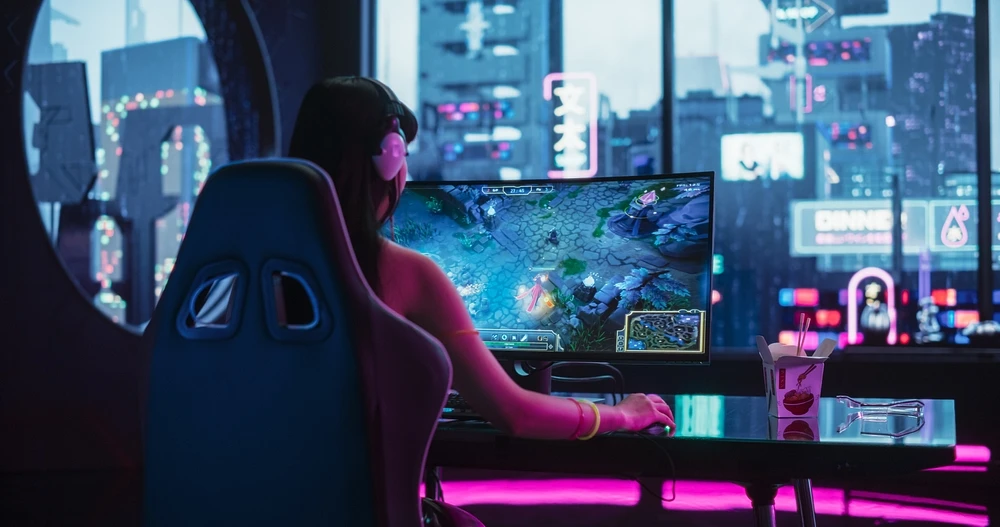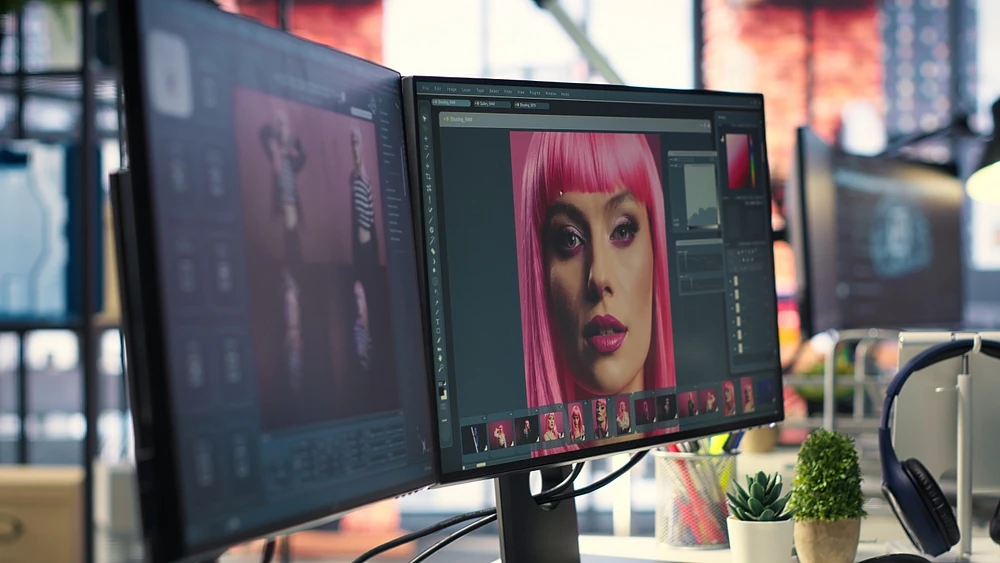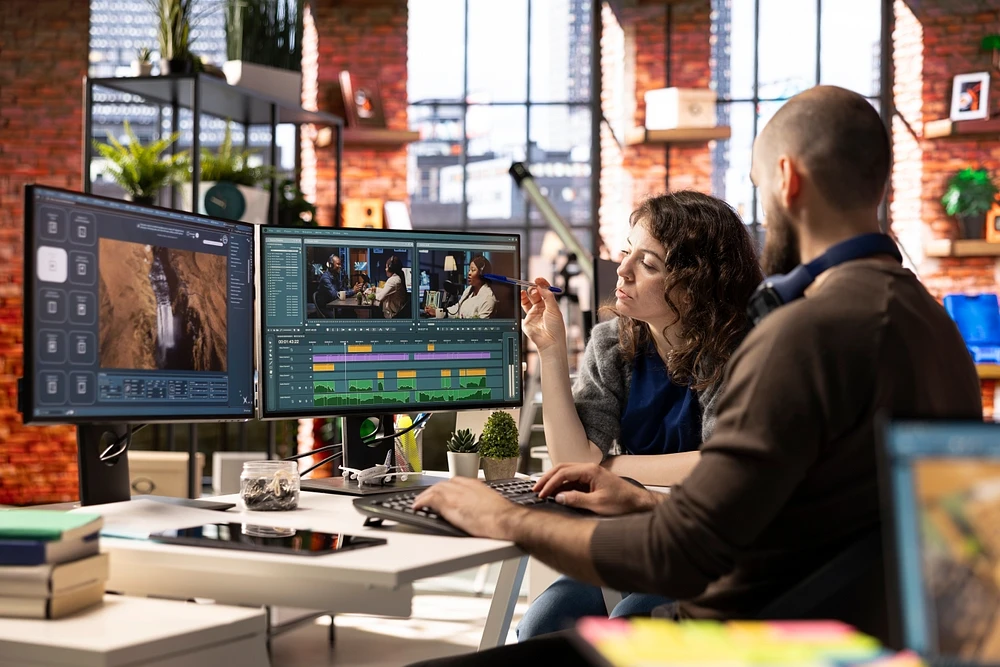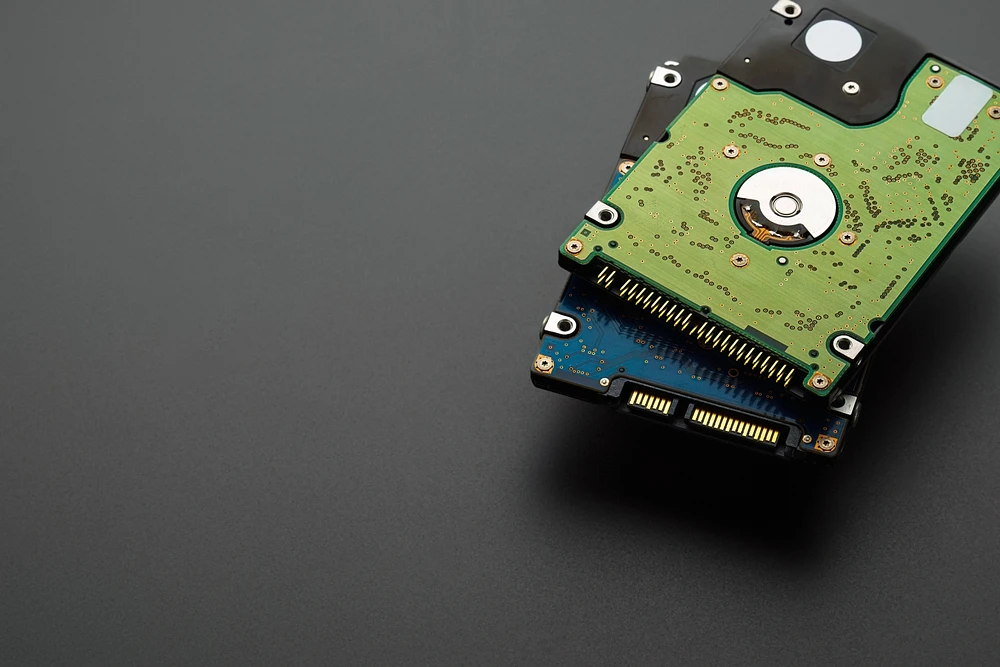TL;DR
Choose Dual Monitors if:
- You're on a tight budget or already own one monitor
- You need strict app separation (email always on one screen)
- You want to mix portrait and landscape orientations
- You prefer proven, universally supported technology
- You need different monitor sizes or brands for specific tasks
Choose an Ultrawide if:
- You work with video editing, coding, or design applications
- You value a clean, minimalist desk aesthetic
- You want an immersive gaming and media experience
- You're willing to invest more upfront for seamless workflow
- You have limited desk space but need maximum screen real estate
The Case for the Ultrawide Monitor

Seamless Real Estate: No Bezels in Your Way
Picture editing a 4K video timeline without a black bezel cutting through the middle of your footage. Imagine scrolling through a massive Excel spreadsheet where columns flow naturally from left to right without interruption. This is where ultrawide monitors shine brightest.
A 34-inch ultrawide with 3440x1440 resolution provides the equivalent screen space of two 24-inch monitors, but without that annoying gap in the center. For developers, this means seeing entire functions without horizontal scrolling. For traders, it means monitoring multiple markets on one continuous display.
The psychological benefit is real too. Your eyes don't need to constantly adjust between different screen boundaries, reducing fatigue during long work sessions.
Immersive Experience for Work and Play
Curved ultrawide monitors wrap around your peripheral vision, creating a more engaging workspace. This isn't just marketing fluff – the subtle curve helps maintain consistent viewing distance across the entire screen width.
For gaming, supported titles transform into cinematic experiences. Popular games like Cyberpunk 2077, Forza Horizon, and most modern shooters support ultrawide resolutions natively, providing competitive advantages and stunning visuals.
Video content benefits significantly too. Movies shot in 21:9 aspect ratio display perfectly without black bars, making your monitor double as an entertainment center.
Aesthetics and Desk Space: The Minimalist Win
One power cable. One display cable. One monitor stand. Ultrawide setups cut down on cable clutter for a much cleaner workspace.
But it's not just about looks. Having fewer cables also means less can go wrong. Cleaning becomes easier, and you gain extra room for a notebook, a coffee mug, or personal items.
Mounting a screen on a wall gets simpler, too. You skip the hassle of placing two separate monitors and dealing with a dual-arm mount. Instead, you just put up one sleek display, and that's it.
Potential Downsides of Ultrawide Monitors
Ultrawide monitors often come with premium price tags. A good 34-inch model can run from $400 to $800. For a similar amount of money, you could get two standard 24-inch monitors, which might total only $300 to $500.
Software can be another consideration. Older programs and some games might not fully support the wide screen. You could see black bars on the sides or a stretched image. Even video calls might act up, cropping your picture in an unflattering way because of the unusual aspect ratio.
You also need a more powerful graphics card. Driving all those pixels at 3440x1440 requires more muscle than running two standard 1080p displays. This is especially important for a smooth gaming experience.
The Case for the Dual Monitor Setup

Unmatched Flexibility and App Separation
Dual monitors excel at creating distinct digital workspaces. Email lives permanently on the left screen. Your main work application owns the right screen. This rigid separation helps maintain focus and establishes consistent workflows.
You can mix orientations – one landscape monitor for general work, one portrait monitor for reading documents or viewing long code files. Try rotating an ultrawide monitor 90 degrees and see what happens (spoiler: it doesn't work).
Different monitor sizes work together seamlessly. A large 27-inch primary display paired with a smaller 24-inch secondary screen creates an asymmetrical setup that many professionals prefer.
The Power of Native Snap Layouts
Windows 11's Snap Layouts and macOS's window management handle multiple discrete screens flawlessly. Dragging a window to the edge of one monitor automatically maximizes it on that screen – no third-party software required.
This native support extends to taskbars, wallpapers, and system-level features. Each monitor can have different wallpapers, and applications remember which screen they were last used on.
Cost-Effectiveness and Accessibility
Most professionals already own one monitor. Adding a second identical or complementary display costs $150-300, instantly doubling your screen real estate.
Even buying two brand-new 24-inch 1080p monitors typically costs less than one quality ultrawide. This budget-friendly approach makes dual setups accessible to students, startups, and cost-conscious professionals.
Replacement costs are lower too. If one monitor fails, you're not completely offline while waiting for repairs or replacements.
Potential Downsides of Dual Monitors
That center bezel interrupts visual flow. Dragging windows across the gap feels clunky compared to seamless ultrawide navigation. Some users find the physical boundary distracting during tasks that require wide visual spans.
Cable management becomes more complex. Two power cables, two display cables, and potentially different connection types create desk clutter that ultrawide setups avoid.
Color and brightness matching between different monitor models can be challenging. Even identical monitors from the same manufacturer may have slight variations that become noticeable during extended use.
Which Setup is Best for Your Profession?

- The Programmer/Coder
For coding, an ultrawide monitor is really nice. Modern IDEs, like VS Code or IntelliJ, love that horizontal space. You can have your main code in the center. A file tree sits on the left. And a terminal or debug console stays open on the right. You see it all without switching windows.
Long lines of code fit neatly, with no annoying wraps. Putting two files side-by-side just works. But some people prefer a different setup: two standard monitors. A popular choice is turning one screen vertically. This portrait mode is great for reading documentation or long log files. So it comes down to a simple choice. Do you want one wide, continuous space? Or do you want a dedicated screen for tall content?
-
The Creative Professional (Video Editor, Graphic Designer)
Video editing heavily favors ultrawide displays. Adobe Premiere Pro, DaVinci Resolve, and Final Cut Pro spread timeline controls across the bottom while maintaining large preview windows above.
Graphic designers benefit from uninterrupted canvas space in Photoshop, Illustrator, and Figma. Color accuracy becomes more important than screen size, so invest in quality panels regardless of your choice.
-
The Data Analyst and Financial Trader
Financial professionals often prefer dual monitors – one portrait for spreadsheets and data tables, one landscape for charts and analysis tools. This orientation maximizes row visibility in Excel or Google Sheets.
Day traders frequently use three or four monitors total, making dual setups more expandable than single ultrawide displays.
-
The Content Writer and Researcher
Writing benefits from focused, distraction-free environments. A single ultrawide can display your writing application alongside research materials, but dual monitors provide clearer separation between active writing and reference materials.
Many writers prefer asymmetrical setups – a large primary display for writing and a smaller secondary screen for research, social media monitoring, or communication tools.
-
The Gamer (Who Also Works)
A good GPU is everything for gaming performance. It’s the heart of it. A well-optimized title runs smoothly, which makes all the difference. Pushing an ultrawide screen is tough on hardware. Only a powerful rig can stop the game from chugging when action gets crazy.
Using two monitors gives you serious screen real estate. It’s great for multitasking. You can have Discord, a stream, or a guide open without constant alt-tabbing. But a second screen can also pull attention away. Many pro players find it hurts focus on the main game.
Conclusion
Choosing between two monitors or one ultrawide screen depends on how you work. Both options give you more room. They, however, feel completely different. Your choice depends on specific tasks and your budget.
A two-monitor setup is very practical. It’s flexible. You can run a full-screen app on each display without a hassle. This option is often easier on your wallet, and it usually works with older computers. It’s great if you need to keep one thing, like reference material, open on one screen while you work on the other. Think of writing with research notes always visible, or coding next to documentation.
An ultrawide screen provides one continuous view. There’s no black bar in the middle to split your spreadsheet or video timeline. This means a cleaner desk and a more focused feel, which is good for more than just games. It helps when editing wide timelines or comparing data. Main drawback is cost. Some games and programs don’t fully support the unusual wide shape.
So, the best choice isn't about a winner. It's about what fits your desk and your mind. Think about software you use every day. Decide if you prefer tasks split across separate screens or everything on a single, wide canvas.
FAQ: Your Ultrawide vs. Dual Monitor Questions, Answered
Is a 49" ultrawide equivalent to two 27" monitors?
Yes. A 49-inch Super Ultrawide screen, with its 5120x1440 resolution, gives you about the same space as two 27-inch QHD monitors placed side-by-side. You just get rid of the bezel right in the middle.
Can you split an ultrawide monitor into two screens?
Absolutely. Most ultrawide monitors have a Picture-by-Picture (PbP) mode. This feature lets you show two different inputs at once. You could connect a work laptop and a personal computer, for example, and use them on a single screen.
Do you need a more powerful graphics card for an ultrawide?
For gaming, yes. Driving all those extra pixels needs a lot more from your GPU. You might see a 30-50% performance drop compared to a standard 1080p display. For office tasks, a modern card will handle it just fine.
Are ultrawide monitors good for programming?
They are great for it. You can see long lines of code without scrolling sideways. It’s also easy to fit your code editor, a terminal window, and a browser all at once. This really helps your workflow.
Which setup is better for reducing neck strain?
It depends. Two monitors let you put a main app on each screen, which can limit how much you turn your head. But an ultrawide lets you keep your main work in the center, with other tools off to the sides. Good positioning is what matters most.
Is it possible to mix an ultrawide with a secondary monitor?
Yes, that’s a common setup. Many people use an ultrawide as their main display and add a smaller monitor turned vertically. This secondary screen is handy for things like email or reference documents.











